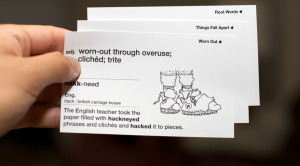 I’ve been obsessed with harmony lately. Those of you who read my last analytical post on harmonic discipline might have guessed as much (yes, I still owe a follow-up to that post, and it’s coming soon!). Specifically, I’ve been experimenting with ways to expand my harmonic vocabulary.
I’ve been obsessed with harmony lately. Those of you who read my last analytical post on harmonic discipline might have guessed as much (yes, I still owe a follow-up to that post, and it’s coming soon!). Specifically, I’ve been experimenting with ways to expand my harmonic vocabulary.
Transcription: a place to start
You know those points in a solo where one of your idols plays an interesting line, something a little unexpected (out), and you think to yourself, “that was cool, but what was it?!” Maybe you’ll go and transcribe that lick; motivated students of the music will probably learn it in all 12 keys, and now you have something cool and new to add to your improvisatory arsenal.
But are you really learning the idea or just the lick?
There’s a critical distinction between plugging in a line and going for an idea.
A lick is limiting: you know a sequence of notes that, in the right context, sound pretty cool. You’ll spend a ton of time learning a lick, then either forget to plug it into your solo or forget it altogether.
An idea is a springboard: you have absorbed the sound of the harmonic or rhythmic gesture you are going to play, and you can freely move in and out of that concept at will. It’s part of your vocabulary, something you have conviction in, and not just a soundbite you’ve memorized or a vocab card that your 9th grade English teacher tested you on (you crammed for the test, never applied the new vocab word in your writing or everyday speech, and thus promptly forgot the meaning of “mercurial” about 15 minutes after the test ended).
Using licks to expand your lexicon
Ok, enough with the lick-bashing. I’ve actually found that licks are a fantastic vehicle for bridging the gap between “holy crap, what did that guy play?!” and gaining complete mastery over a new harmonic or rhythmic idea.
Let’s walk through an example. I’ve been digging the sound of “sidestepping” up a minor third in minor keys: i.e. over a C-minor chord, moving back and forth between Cm and Ebm. So, I sat for a minute and worked out a little line that gets me in, out, and back in again:
Now you could go home, steal my little lick, and have a nifty nugget to plug into your next solo. But that’s not the point. Remember the goal: to master the superimposition of the minor that’s a minor-third above the tonic.
Here’s what I’ve been doing to try to drive home this new concept:
- Learn the lick (or better yet, create your own!)
- Play it over and over, until you don’t have to think about it and can play the lick at max tempo while checking your Facebook news feed…
- Mess with the lick: extend the harmonic sidestep with a few notes on either end, change up the rhythm, etc. Try to feel at home moving between Cm and Ebm.
- Look for the “pivot points”. Looking only at the Cm and Ebm pentatonic, they share Eb & Bb, and Db to C and Gb to G are 1/2 steps apart. These are good points of departure or resolution for sidestepping. My lick used the top Eb to get me back to Cm from Ebm.
- Learn the original lick in all 12 keys. Remember, you want to learn the idea, and bringing it through various keys reinforces the sound in your ear while starting to give you the freedom to utilize your new idea at your leisure. Don’t write it out, think about the harmony you are implying.
- Play around with the concept in all 12 keys. Become fluent in this idea by taking one key at a time and moving back and forth over the concept.
- Test the idea in context. Find a tune to plug in your new vocabulary. I’ve been trying to work it into every minor landing point in Invitation. Not easy!
It’s a process, but for me the payoff is well worth the investment.

